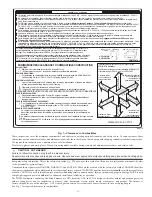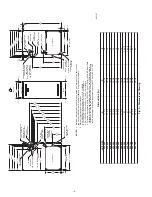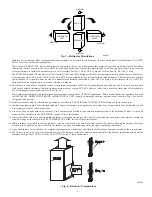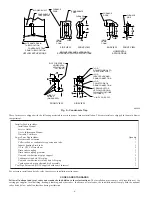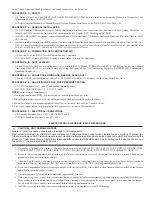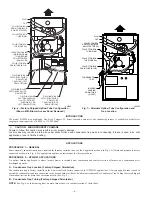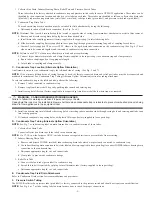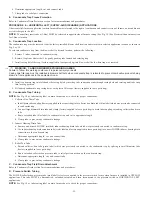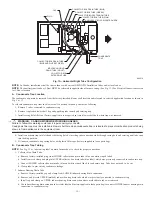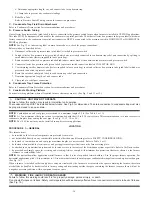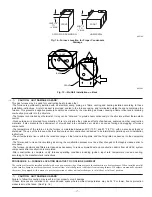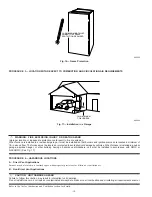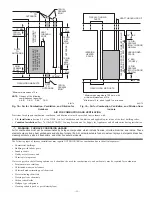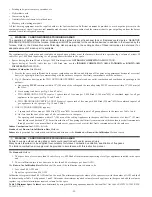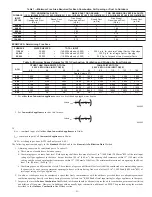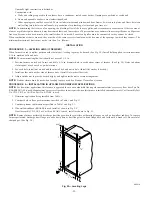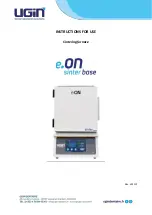
In the United States and Canada, follow all codes and standards for the following:
PROCEDURE 1—SAFETY
•
US: National Fuel Gas Code (NFGC) NFPA 54-2002/ANSI Z223.1-2002 and the Installation Standards, Warm Air Heating and Air
Conditioning Systems ANSI/NFPA 90B
•
CANADA: National Standard of Canada, Natural Gas and Propane Installation Code (NSCNGPIC) CSA B149.1-00
PROCEDURE 2—GENERAL INSTALLATION
•
US: NFGC and the NFPA 90B. For copies, contact the National Fire Protection Association Inc., Batterymarch Park, Quincy, MA 02269; or
for only the NFGC contact the American Gas Association, 400 N. Capitol, N.W., Washington DC 20001
•
CANADA: NSCNGPIC. For a copy, contact Standard Sales, CSA International, 178 Rexdale Boulevard, Etobicoke (Toronto), Ontario, M9W
1R3, Canada.
•
A manufactured (Mobile) home installation must conform with the Manufactured Home Construction and Safety Standard, Title 24 CFR, Part
3280, or when this standard is not applicable, the Standard for Manufactured Home Installation (Manufactured Home Sites, Communities, and
Set-Ups), ANSI/NCS A225.1, and/or CAN/CSA-Z240, MH Series Mobile Homes
PROCEDURE 3—COMBUSTION AND VENTILATION AIR
•
US: Section 8.3 of the NFGC, Air for Combustion and Ventilation
•
CANADA: Part 7 of the NSCNGPIC, Venting Systems and Air Supply for Appliances
PROCEDURE 4—DUCT SYSTEMS
•
US and CANADA: Air Conditioning Contractors Association (ACCA) Manual D, Sheet Metal and Air Conditioning Contractors National
Association (SMACNA), or American Society of Heating, Refrigeration, and Air Conditioning Engineers (ASHRAE) 2001 Fundamentals
Handbook Chapter 34.
PROCEDURE 5—ACOUSTICAL LINING AND FIBROUS GLASS DUCT
•
US and CANADA: current edition of SMACNA, NFPA 90B as tested by UL Standard 181 for Class I Rigid Air Ducts
PROCEDURE 6—GAS PIPING AND GAS PIPE PRESSURE TESTING
•
US: NFGC; chapters 5, 6, 7, and 12 and national plumbing codes
•
CANADA: NSCNGPIC Part 3, 4, 5, A, B, E, and H.
NOTE:
In the state of Massachusetts:
1. Gas supply connections MUST be performed by a licensed plumber or gas fitter.
2. When flexible connectors are used, the maximum length shall not exceed 36 inches (915 mm).
3. When lever handle type manual equipment shutoff valves are used, they shall be T-handle valves.
4. The use of copper tubing for gas piping is NOT approved by the state of Massachusetts.
PROCEDURE 7—ELECTRICAL CONNECTIONS
•
US: National Electrical Code (NEC) ANSI/NFPA 70-2002
•
CANADA: Canadian Electrical Code CSA C22.1
ELECTROSTATIC DISCHARGE (ESD) PRECAUTIONS
CAUTION: UNIT DAMAGE HAZARD
Failure to follow this caution may result in damage to unit components.
Electrostatic discharge can affect electronic components. Take precautions during furnace installation and servicing to protect the
furnace electronic control. Precautions will prevent electrostatic discharges from personnel and hand tools which are held during the
procedure. These precautions will help to avoid exposing the control to electrostatic discharge by putting the furnace, the control, and
the person at the same electrostatic potential.
1. Disconnect all power to the furnace. Multiple disconnects may be required. DO NOT TOUCH THE CONTROL OR ANY WIRE
CONNECTED TO THE CONTROL PRIOR TO DISCHARGING YOUR BODY’S ELECTROSTATIC CHARGE TO GROUND.
2. Firmly touch a clean, unpainted, metal surface of the furnace chassis which is close to the control. Tools held in a person’s hand during
grounding will be satisfactorily discharged.
3. After touching the chassis, you may proceed to service the control or connecting wires as long as you do nothing that recharges your body
with static electricity (for example; DO NOT move or shuffle your feet, DO NOT touch ungrounded objects, etc.).
4. If you touch ungrounded objects (recharge your body with static electricity), firmly touch a clean, unpainted metal surface of the furnace
again before touching control or wires.
5. Use this procedure for installed and uninstalled (ungrounded) furnaces.
6. Before removing a new control from its container, discharge your body’s electrostatic charge to ground to protect the control from damage.
If the control is to be installed in a furnace, follow items 1 through 5 before bringing the control or yourself into contact with the furnace.
Put all used AND new controls into containers before touching ungrounded objects.
7. An ESD service kit (available from commercial sources) may also be used to prevent ESD damage.
—7—
→
Summary of Contents for PG9MAA
Page 70: ... 70 ...
Page 71: ... 71 ...



